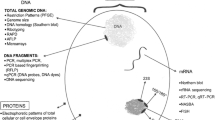Abstract
Seventeen Serratia marcescens strains were isolated from patients admitted to a hospital in the Tokyo metropolitan area. In order to study their genetic diversity, pulsed-field gel electrophoresis (PFGE) was performed. Clear bands were not observed by the standard PFGE technique following the instruction manual from the company. To obtain clear results, it was necessary to include some additional steps to the preparation of PFGE samples. We added an inactivation step for DNase using formaldehyde, and the bacterial strains were embedded in thinner plug molds than usual. These modifications were effective with all strains, and the complete PFGE pattern was obtained in the samples treated with formaldehyde and using thin plug molds. We established a rapid method to obtain a high-quality PFGE result for S. marcescens.
Similar content being viewed by others
Author information
Authors and Affiliations
Additional information
Received: March 19, 2002 / Accepted: July 10, 2002
About this article
Cite this article
Ishii, Y., Alba, J., Kimura, S. et al. Rapid pulsed-field gel electrophoresis technique for determination of genetic diversity of Serratia marcescens . J Infect Chemother 8, 368–370 (2002). https://doi.org/10.1007/s10156-002-0195-5
Issue Date:
DOI: https://doi.org/10.1007/s10156-002-0195-5




